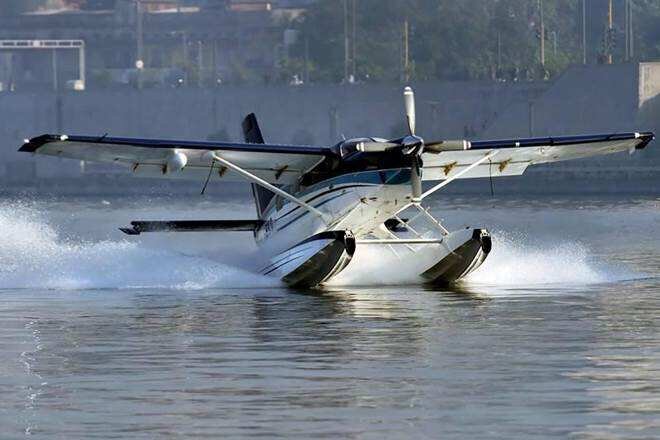India’s First Seaplane Project | 26 Oct 2020
Why in News
India's first seaplane service in Gujarat, is set to start from 31st October 2020, the birth anniversary of Sardar Vallabhbhai Patel, with the aim of providing air connectivity between the Sabarmati Riverfront in Ahmedabad and the Statue of Unity in Kevadia.
- The seaplane will be operated by SpiceJet. It is a 19-seater seaplane, which will be able to accommodate 14 passengers.
- In the next phase, Dharoi dam (Mehsana district) will connect Ambaji and Shatrunjay dam (Bhavnagar district) and Tapi district.
Key Points
- Seaplane:
- A seaplane is a fixed-wing aeroplane designed for taking off and landing on water.
- There are two main types of seaplanes: flying boats (often called hull seaplanes) and floatplanes.
- A flying boat is a fixed-winged seaplane with a hull, allowing it to land on water, that usually has no type of landing gear to allow operation on land. It differs from a floatplane as it uses a purpose-designed fuselage which can float, granting the aircraft buoyancy
- The bottom of a flying boat’s fuselage is its main landing gear. This is usually supplemented with smaller floats near the wingtips, called wing or tip floats.
- The hull of a flying boat holds the crew, passengers, and cargo; it has many features in common with the hull of a ship or a boat.
- A floatplane is supported on the water by pontoons, called floats.
- A flying boat is a fixed-winged seaplane with a hull, allowing it to land on water, that usually has no type of landing gear to allow operation on land. It differs from a floatplane as it uses a purpose-designed fuselage which can float, granting the aircraft buoyancy
- Countries that Operate Seaplanes:
- Seaplanes are operational in countries like the Philippines, Canada, Australia, the United States, Finland, the United Kingdom, Sri Lanka, Fiji, New Zealand, Papua New Guinea, United Arab Emirates, Italy, Maldives and Hongkong.
- In India, Jal Hans, a commercial seaplane service based in the Andaman and Nicobar Islands was launched as a pilot project in December 2010 with a capacity of 10 passengers.
- India's Seaplane Project:
- As per the direction of the Centre, the Airports Authority of India (AAI) requested state governments of Gujarat, Assam, Andhra Pradesh and Telangana and the administration of Andaman & Nicobar to propose potential locations for setting up water airports to boost the tourism sector.
- In 2019, the Centre approved flights from six water airports that include Shatrunjay Dam (Gujarat), Guwahati riverfront and Umrangso reservoir (Assam) and Nagarjuna Sagar (Andhra Pradesh), under the third round of Ude Desh Ka Aam Nagrik (UDAN) scheme.
- The routes awarded for seaplane operations include Sabarmati riverfront to Statue of Unity and Shatrunjay Dam; Guwahati riverfront to Umrango reservoir, Jorhat and Shillong (Meghalaya) and Nagarjuna Sagar to Vijayawada and Hyderabad (Telangana).
- Agatti, Kavaratti and Minicoy islands of Lakshadweep have also been proposed to be connected through the seaplane project under the fourth round of UDAN scheme.
- Benefit:
- The project will lead to an increase in tourism and hotel business at local level. It will also serve employment to local people.
- Establishment of water airports will contribute to an increase in the level of current social infrastructural facilities at the proposed sites.
- Impact on Environment:
- Negative: Experts are of the opinion that the activities proposed under the water airport project may have a similar type of impact as that of an airport.
- However, the water airport is not a listed project/activity in the Schedule to the Environmental Impact Assessment (EIA) Notification, 2006 nor in EIA draft 2020.
- Positive: During seaplane operations, there will be turbulence created in the water while takeoff and landing of seaplanes.
- This will lead to mixing of oxygen in the water, which will have a positive impact on the aquatic ecosystem near seaplane operations increasing oxygen content and decreasing carbon content in this system.
- Negative: Experts are of the opinion that the activities proposed under the water airport project may have a similar type of impact as that of an airport.
UDAN Scheme
- Ude Desh Ka Aam Naagrik (UDAN) was launched as a regional connectivity scheme under the Ministry of Civil Aviation in 2016.
- The objective of the scheme is to create affordable yet economically viable and profitable flights on regional routes so that flying becomes affordable to the common man even in small towns.
- The scheme envisages providing connectivity to un-served and underserved airports of the country through the revival of existing air-strips and airports. The scheme is operational for a period of 10 years.
- Under-served airports are those which do not have more than one flight a day, while un-served airports are those where there are no operations.
- UDAN 3.0 and UDAN 4.0 aim to include Seaplanes for connecting water airports.
